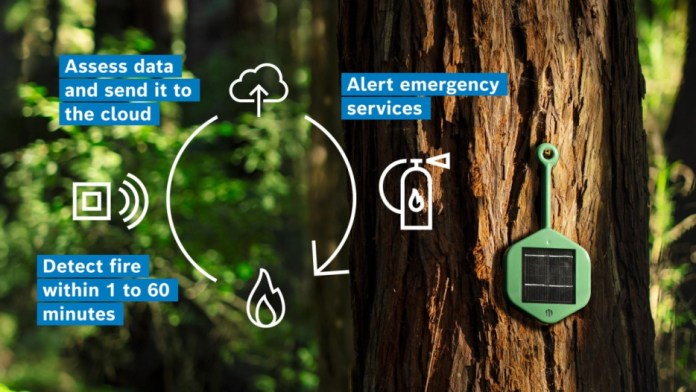EE Times’ inaugural Green Engineering Summit explored how the industry can help achieve net-zero carbon dioxide emissions through the use of new technologies and innovations. One of the hot topics at the virtual conference focused on how to achieve substantial reductions in greenhouse gas emissions. A technical session, presented by Bosch Sensortec, showed how tiny digital gas sensors can help reduce global carbon emissions by detecting wildfires before they get out of control.
Bosch Sensortec’s BME688 four-in-one gas sensor with artificial intelligence can detect trace amounts of fire gases and trigger an alarm before a fire spreads. Fire releases greenhouse gases and up to 20% of annual global carbon emissions is caused by forest fires, said keynote speaker Stefan Finkbeiner, CEO and general manager of Bosch Sensortec.
Finkbeiner’s keynote, “How a Digital Nose Protects the Climate and Improves Air Quality,” discussed how the environmental sensor with AI can be used in a network of sensor nodes and the cloud for the early detection of wildfires. A key focus of the keynote is the BME688, claimed as the first gas sensor with AI that delivers a combination of high-accuracy pressure, humidity, temperature, and gas sensing.
This environmental sensor is housed in a very small package, measuring 3.0 × 3.0 × 0.9 mm³. It can detect volatile organic compounds (VOCs), volatile sulfur compounds (VSCs), and other gases like carbon monoxide and hydrogen in the parts per billion (ppb) range.
The gas scanner can be customized for sensitivity, selectivity, data rate, and power consumption. In addition, designers can use the BME AI-Studio tool to train the BME688 gas scanner for specific applications in a variety of home appliance, IoT, or smart-home products. A key feature of the software is that it allows for the collection of data from all sensors in the field to continuously improve the algorithm for their specific use case, and we’ll find out why this is important for detecting wildfires.
These features also make the “digital nose” suited for a variety of environmental sensing applications. Finkbeiner cited a myriad of connected and smart-home applications for the gas sensor, ranging from detecting bad breath and spoiled food in the fridge to wildfires and indoor/outdoor air quality. But for this presentation, he focused on the wildfire-detection application.

Figure 1: The BME688 gas sensors are incorporated into small, solar-powered sensor devices that hang from trees for early wildfire detection. (Source: Bosch Sensortec)
Preventing wildfires with gas sensors
Through a partnership with Dryad Networks, the BME688 sensors with an IoT network are used for ultra-early detection of forest fires, and fewer fires mean lower CO2 emissions, said Finkbeiner.
The BME688 is a digital gas sensor with an AI solution in this application, which means it has a connection to a microcontroller and a software toolkit, which also helps to customize the applications of this sensor and make it suitable to different applications, including fire detection, said Finkbeiner. “It’s a trainable solution with an AI interface, which can be programmed to specific solutions.”
The solar-powered Dryad Silvanet Wildfire Sensor, which houses the BME688, is designed to detect forest fires during the early stages, even at the smoldering phase. It leverages a combination of ultra-low–power air-quality sensing with high-accuracy gas sensing (including hydrogen, carbon monoxide, and carbon monoxide) with AI to detect a fire. It uses LoRaWAN communications for wireless data transmission.
The BME688 enables the profiling of different gases in the environment and determines the concentration of the different gases.

Figure 2: The Dryad AIoT fire-detection system sends the sensor data to the cloud, where it is analyzed and monitored, and alerts are sent to emergency services. (Source: Bosch Sensortec)
Finkbeiner explained that the BME688 sensors — housed in the small, solar-powered sensor devices, attached to trees, and networked together — collect data throughout the forest. The sensor data is sent to the cloud for monitoring and analysis, as well as for automatic training of machine-learning algorithms. Alerts are sent when emerging wildfires are detected. It can detect fire within one to 60 minutes.
The ultra-early AIoT fire detection “enables firefighters to extinguish wildfires before they spread,” said Finkbeiner. They reduce “firefighting costs, [reduce] financial damage to the economy, and, most importantly, save humans and wildlife.”
“The data from the different sensors are sent to a cloud; it’s then analyzed in the cloud, and it’s also a self-learning system, so I can also use all the data to improve the application right now,” he said. “With this analyzed data, I can then decide if the gas mixture that I detect is the footprint for an upcoming wildfire and use this analyzed data to make a call to the fire brigade to come into the forest before you even have the fire or the smoke visible around the area and hopefully prevent big wildfires with this system.”
The over-the-air updates continuously improve and update Dryad’s AI to deliver higher accuracy in the detection of emerging wildfires.
The solar-powered devices have a digital interface, so there are connections between the different sensors, which can be spread out over the forest to provide the data of the air quality or the gas constitution around these sensors, said Finkbeiner. With the Dryad system, you can detect the changes in the gases within a forest and detect very early before you have the fire, he added.
“Hopefully a lot of wildfires can be avoided, or it can be at least detected very early to avoid a large spread and therefore help to reduce the CO2 emissions,” he said.
Finkbeiner’s talk also covered several pressure-sensor use cases. Environmental sensor examples include the BMP581, which can be used for a variety of applications, such as fitness, indoor localization, and indoor navigation.
Advertisement
Learn more about Bosch Sensortec





